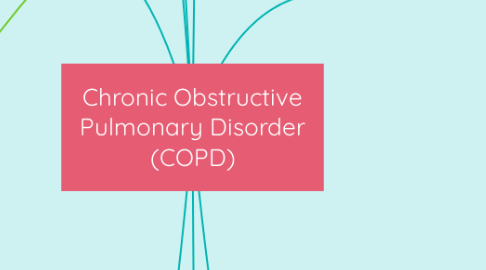
1. Clinical Manifestations
1.1. Shortness of breathe, especially with physical activity
1.1.1. Lung function is altered which prevents them from working properly
1.2. Wheezing
1.3. Constantly having to clear throat
1.3.1. Due to excess mucus in the lungs
1.4. Peripheral cyanosis
1.5. Frequent respiratory infections
1.6. Lack of energy
1.7. Unintended weight loss
1.8. Swelling in ankles, feet or legs
1.9. Chest tightness
1.10. Chronic cough
1.10.1. Which may produce mucus that may be clear, white, yellow, or greenish
2. Treatment
3. Risk Factors
3.1. Smoking
3.1.1. Main risk for COPD
3.1.2. Causes 90% of COPD deaths
3.1.3. Long- term exposure to tobacco smoke is dangerous
3.1.4. The longer you smoke and the more packs you smoke, the greater the risk of developing COPD
3.1.5. Exposure to secondhand smoke also increases risk
3.2. Air pollution
3.2.1. Can cause condition if exposure is intense or prolonged
3.2.2. Examples: poorly ventilated wood stoves, burning biomass or coal, or cooking with fire
3.2.3. Indoor air pollution includes particle matter from the smoke of solid fuel used for cooking and heating
3.3. Occupational dusts and chemicals
3.3.1. People exposed to dust and chemical vapors, such as coal miners, grain handlers, and metal molders
3.4. Genetics
3.4.1. Result in a lack of alpha 1 antitrypsin (AAT)
3.5. Age
3.5.1. Most common in people at least 40 years of age who have a history of smoking
3.5.2. Incidence increases with age
4. Treatment
4.1. Smoking cessation
4.2. Medications
4.2.1. Bronchodilators
4.2.2. Inhaled steroids
4.2.3. Combination inhalers
4.2.4. Oral steroids
4.2.5. Phosphodiesterase-4 inhibitors
4.2.6. Theophylline
4.2.7. Antibiotics
4.3. Lung therapies
4.3.1. Oxygen therapy
4.3.2. Pulmonary rehabilitation program
4.4. Managing exacerbations
4.5. Surgery
4.5.1. Lung volume reduction surgery
4.5.2. Lung transplant
4.5.3. Bullectomy
5. Sources
5.1. Hubner, R. H., & Herzog, D. (2016). COPD treatment: about collateral channels and collapsing airways.
5.2. De Marco, R., Pesce, G., Marcon, A., Accordini, S., Antonicelli, L., Bugiani, M., ... & Pirina, P. (2013). The coexistence of asthma and chronic obstructive pulmonary disease (COPD): prevalence and risk factors in young, middle-aged and elderly people from the general population. PloS one, 8(5), e62985.
6. COPD. (2017, August 11). Retrieved September 28, 2017, from http://www.mayoclinic.org/diseases-conditions/copd/diagnosis-treatment/diagnosis/dxc-20204917
7. Incidence/ Prevalence
7.1. 30 million Americans affected
7.2. 2013 marked the first year that COPD was over all 50 states
7.3. The prevalence rate is estimated to be 7.6% in the United States
7.4. There are an estimated 64 million people living with COPD in the world
7.5. COPD affects twice as many males as females
7.6. On average approximately 5-15% of adults in industrialized countries have COPD
7.7. The number of deaths from COPD has increased more than 60% over the last 20 years
8. Diagnosis Testing
8.1. Lung (pulmonary) function test
8.1.1. Measures the amount of air you can inhale and exhale, and if your lungs are delivering enough oxygen to your blood
8.1.2. Spirometry
8.1.2.1. Most common type
8.1.2.2. Can detect COPD before S & S
8.1.2.3. Patient blows into a large tube connected to a spirometer
8.1.2.4. Can track the progression of disease and how well treatment is working
8.1.3. Lung volumes
8.1.4. Diffusing capacity
8.1.5. Oximetry
8.2. Chest X-ray
8.2.1. Can show emphysema
8.2.2. Can rule out other lung problems of heart failure
8.3. CT scan
8.3.1. Can detect emphysema
8.3.2. Determine if patient might benefit from surgery
8.4. Arterial blood gas analysis
8.4.1. Blood test which measures how well your lungs are bringing in oxygen into your blood and removing carbon dioxide
8.5. Personal and family history
8.5.1. Knowing AAt gene mutation or level of exposure to smoke or second hand smoke
9. Pathogenesis
9.1. Stage 1- Mild COPD
9.1.1. People may not realize that they have a problem
9.1.2. Many people continue with their daily activities with slight limitations to their breathing
9.1.3. Some may experience a cough or phlegm
9.2. Stage 2- Moderate COPD
9.2.1. Many people notice more coughing and mucus production
9.2.2. Doctor may prescribe bronchodilators to help breathing
9.2.3. Pulmonary rehabilitation is recommended
9.3. Stage 3- Severe COPD
9.3.1. Lung function continues to decline
9.3.2. Breathing becomes more difficult as well as daily activities
9.3.3. Doctor may prescribe corticosteroids to help reduce inflammation
9.4. Stage 4- Very Severe COPD
9.4.1. Flare- ups and breathing issues may become life threatening
9.4.2. Many people have trouble receiving enough oxygen which could lead to hypoxia or hypoxemia and cyanosis
9.4.3. Doctor may prescribe oxygen therapy to ensure body receives adequate oxygen
